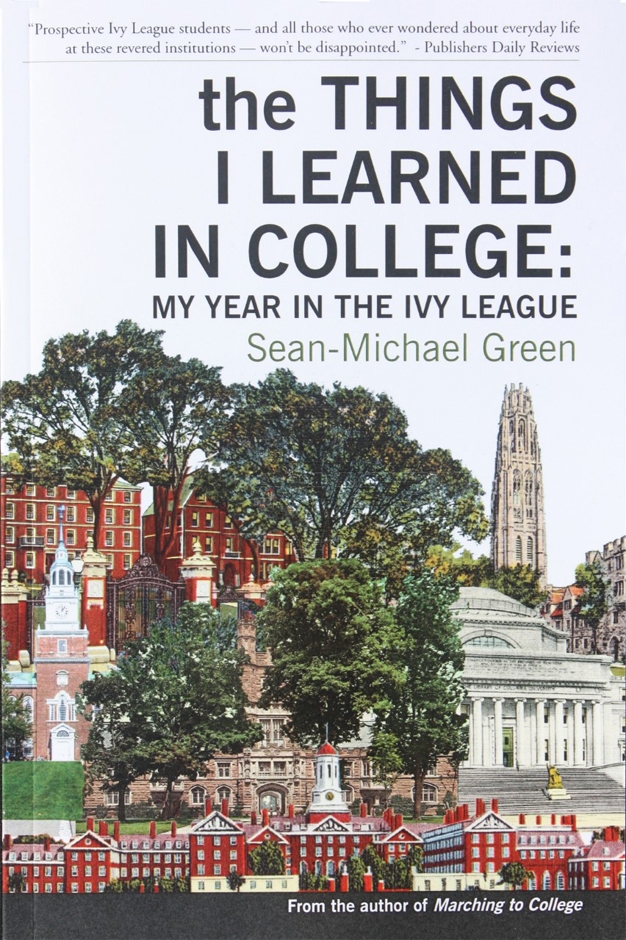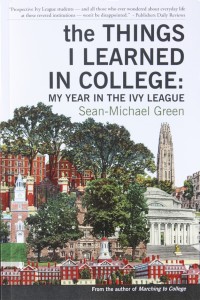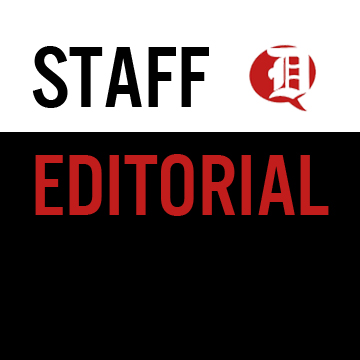
By Nicole Prieto | The Duquesne Duke

Author Green previously wrote “Marching to College,” examining military experience in college.
To say that author Sean-Michael Green loves college would be an understatement. Boasting degrees from four institutions and studies at another three, the former U.S. Marine, native Pittsburgher and “college freak” decided to take on an ambitious project: to visit each school in the Ivy League during an academic year.
Starting with Cornell University, Green’s “The Things I Learned in College: My Year in the Ivy League” takes readers on a layman’s journey past the prestige of the nation’s eight Ivies. He devotes about a month to each school, where he takes classes, parties with students and contends with university administration. What follows is a bemusing romp through the upper echelons of higher education that is, unfortunately, not as exciting as readers may hope.
It must be said: The book reads like a dated admissions brochure. The Ivy-bound need only look to it as a frank, but otherwise glowing, assessment of each renowned institution — perhaps with the exception of the University of Pennsylvania, which Green visits twice.
Green’s tone is honest and down-to-earth. He is unafraid of crude language and of unflattering judgments about people he encounters. But his overbearing love of college casts a rose-tinted light on nearly every school he visits. (Notably, the phrase “my favorite(s)” appears almost 30 times in the text.)
This makes one question whether he has a better understanding about an Ivy than an awestruck parent on a campus tour. In fact, going on official tours is something Green makes a point of doing on his journey. As any seasoned undergraduate knows, the notorious, physically obstructive affair is not a great way to get an honest assessment of a school.
To his credit, Green admits he is not journalistically trained. His lack of an investigative drive to truly dig past the pomp and circumstance is apparent.
“I was seeking an ideal of the Ivy League,” he writes, and that is part of the problem for readers starved for some credibility. His verisimilitude already comes into question often enough. His inability to touch base with any Harvard students, for instance, is a glaring weakness of the “Harvard” chapter.
After failing to solicit student interviews via flyers, and by hoping that students would eventually reach out to him, Green never speaks to anyone attending Harvard. Instead, he spends time with students from a neighboring campus: the Massachusetts Institute of Technology. His lone communication with a Harvard undergrad is an email from a woman who hopes his visit “was not too displeasing” — sent a day before he has to move on.
Nevertheless, Green is willing to delve into honest, uncomfortable conversations about prejudice, politics and fraternity culture when they do arise, and that is where his project truly shines. His conversations and experiences with students are a blend of frightening and touching accounts. He relays their anger, passion and enthusiasm convincingly — breathing life into his personal journal. The students truly are the ones who make the story, and focusing more on their narratives would have made for a more compelling read.
Aside from secret societies and a few unimaginable amenities, these Ivy attendees’ experiences are hardly unfamiliar. Frat party drama, parents more invested in the schools than their students, interschool rivalries, diversity issues, questionable living arrangements and a litany of insecurities seem to be constants in higher education, no matter the school. Move past the cultural mystique of elitism and selectivity, and they are your typical college students, maybe with an extra dash of “overachiever.”
Stylistically, Green displays a few odd quirks in his writing. Some of his “favorite” asides in the beginning of chapters are laborious digressions into the schools’ architectural histories that seem better suited in a book report. Additionally, the text is not free from comments worthy of some side-eyeing.
Green, for example, feels the need to remind readers of his heterosexuality when he notices a male student’s attractiveness, and his incidental descriptions of women are to be desired. He speculates that a woman in Brown University’s Admissions Office likely had not “seen double digits on her birthday cards in a long time.” When inquiring about a campus tour, he was momentarily concerned that she was directing him “to the basement to meet her inbred, chainsaw-loving offspring.”
Anyone cynical about higher education may not find much enjoyment in “The Things I Learned in College.” Those who can claim an Ivy as an alma mater may have a few choice words for Green’s account. His book is, ultimately, a lackluster preview of what it is like to be a student in the Ivy League, and it does not help that his experiences are over 10 years old. Still, Green’s project remains a worthy undertaking. Perhaps it is now due for a more thorough, contemporary follow-up.

